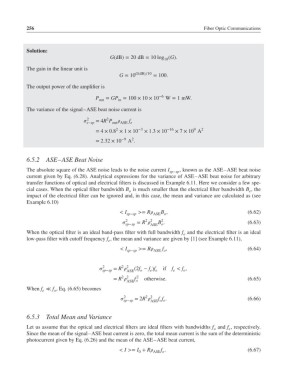Page 275 - Fiber Optic Communications Fund
P. 275
256 Fiber Optic Communications
Solution:
G(dB)= 20 dB = 10 log (G).
10
The gain in the linear unit is
G = 10 G(dB)∕10 = 100.
The output power of the amplifier is
P out = GP = 100 × 10 × 10 −6 W = 1mW.
in
The variance of the signal–ASE beat noise current is
2
2 s−sp = 4R P f
out ASE e
9
2
= 4 × 0.8 × 1 × 10 −3 × 1.3 × 10 −16 × 7 × 10 A 2
2
= 2.32 × 10 −9 A .
6.5.2 ASE–ASE Beat Noise
The absolute square of the ASE noise leads to the noise current I sp−sp , known as the ASE–ASE beat noise
current given by Eq. (6.28). Analytical expressions for the variance of ASE–ASE beat noise for arbitrary
transfer functions of optical and electrical filters is discussed in Example 6.11. Here we consider a few spe-
cial cases. When the optical filter bandwidth B is much smaller than the electrical filter bandwidth B ,the
o e
impact of the electrical filter can be ignored and, in this case, the mean and variance are calculated as (see
Example 6.10)
< I >= R B , (6.62)
sp−sp ASE o
2 2
2 sp−sp = R ASE o 2 (6.63)
B .
When the optical filter is an ideal band-pass filter with full bandwidth f and the electrical filter is an ideal
o
low-pass filter with cutoff frequency f , the mean and variance are given by [1] (see Example 6.11),
e
< I >= R f , (6.64)
sp−sp ASE o
2 2
2
sp−sp = R ASE (2f − f )f if f < f ,
o
o
e e
e
2 2 2
= R f otherwise. (6.65)
ASE o
When f ≪ f , Eq. (6.65) becomes
o
e
2
2 2
f f .
sp−sp = 2R ASE o e (6.66)
6.5.3 Total Mean and Variance
Let us assume that the optical and electrical filters are ideal filters with bandwidths f and f , respectively.
o e
Since the mean of the signal–ASE beat current is zero, the total mean current is the sum of the deterministic
photocurrent given by Eq. (6.26) and the mean of the ASE–ASE beat current,
< I >= I + R ASE o (6.67)
f .
0

